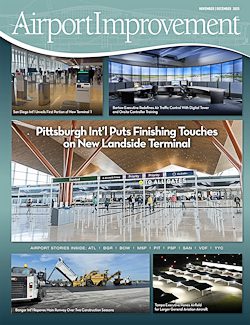San Francisco International Airport (SFO) is turning heads with the architecture and art in Harvey Milk Terminal 1, but the rebuilt facility also includes some important less visible features. The new baggage handling system is one of its hardest-working hidden gems.
San Francisco International Airport (SFO) is turning heads with the architecture and art in Harvey Milk Terminal 1, but the rebuilt facility also includes some important less visible features. The new baggage handling system is one of its hardest-working hidden gems.
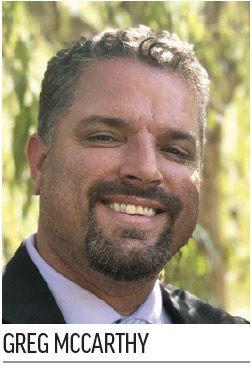 Airport officials report the $180 million investment is already helping meet several of SFO’s overarching goals, including increased functionality, greater flexibility, reduced cost of ownership and revolutionizing the passenger experience. The project is also putting SFO on the map as the first U.S. airport to install a baggage handling system that carries each bag in a separate tote that can be tracked through the entire system.
Airport officials report the $180 million investment is already helping meet several of SFO’s overarching goals, including increased functionality, greater flexibility, reduced cost of ownership and revolutionizing the passenger experience. The project is also putting SFO on the map as the first U.S. airport to install a baggage handling system that carries each bag in a separate tote that can be tracked through the entire system.
When SFO began planning its Terminal 1 redevelopment program, updating the baggage system was a given, explains Project Manager Greg McCarthy. What wasn’t immediately apparent, however, was the type of system that would best meet the busy facility’s needs. That required considerable research.
|
Project: New Baggage Handling System Location: San Francisco Int’l Airport Site: Harvey Milk Terminal 1 Cost: $180 million (including interim system used during construction) System Provider: BEUMER Group High Level Controls: Brock Solutions Tote System: CrisBag, by BEUMER Group Baggage Mezzanine: KPFF Seismic Engineering: Huntington Design Associates Electric Designer: Redwood Electric Terminal 1 Center Design-Builder: Hensel Phelps/Gensler/Kuth Ranieri Boarding Area B Design-Builders: Austin Commercial & Webcor Builders Joint Venture HKS/WoodsBagot/ED2 International/KYA Noteworthy Detail: First installation of a tote-based baggage handling system in the U.S. |
At the time, the 1960s-era terminal had several airline-owned systems dotting its landscape. With six independent systems and 15 CTX checked baggage screening machines, the operation lacked function and was expensive to operate and maintain, notes McCarthy.
“The idea was to consolidate it into one centralized screening system that is airport-owned and have the airlines drive off of that, as opposed to having the airlines handle the project and take the risk of it not working with our building or other systems,” he explains. A consolidated system allows the airlines to share the cost of using a single system, and also provides more efficient and flexible operations for the airport, airlines and TSA screening. As a common-use terminal, flexibility was critical.
The airport used a competitive selection process to find a design build partner, and chose BEUMER Group in 2015. The project team also engaged airport officials, airlines and TSA to help outline the needs and goals of the terminal’s new baggage handling system.
BEUMER analyzed the features, benefits, technologies and cost of multiple baggage handling options and presented the project team with two primary options: a conventional belt-based system and a tote-based independent carrier system. Airports throughout Canada, Europe, Asia and the Middle East have used tote-based systems for about 20 years, but they are a relatively new concept in North America.
Stakeholders at SFO identified safety, reduced energy usage, tracking capability and total cost of ownership as key attributes. And based on that list, a tote-based independent carrier system stood out, says McCarthy. Ultimately, SFO chose the CrisBag® system from BEUMER.
Multiple Enhancements
McCarthy explains that moving to a single baggage handling system improves the efficiency of operations throughout Terminal 1, allows greater flexibility for the airlines and delivers a consolidated and optimized process for screening checked bags. Moreover, the CrisBag system allows SFO to track and trace individual bags throughout the entire handling system.
With a typical airport-owned handling system, airlines don’t know where their bags are in the facility. “That’s difficult,” McCarthy remarks.
But when multiple airlines manage their own individual systems, operations, maintenance and systems integration can be problematic. That’s not ideal either.
“How many times have you gotten off a plane and waited for bags? Or checked a bag and then had no idea where it was?” asks McCarthy.
SFO’s strategy is designed to offer the best of both worlds: a single, airport-owned system used by all airlines that allows them to know where their passengers’ bags are at all times.
Tracking is a tremendous advantage of the new system in Terminal 1, stresses McCarthy. Now, each inbound bag remains inside its own individually controlled tote—from off-loading at the gate to a claim device inside the terminal. A radio frequency identification (RFID) technology device on each tote provides 100% tracking once a bag enters the system, explains David Delaney, a project director with BEUMER. “You’re not losing bags, and there are no bag jams,” he notes.
 The airport provides tracking information from the RFID-equipped totes to its airlines and lets them chose whether or not to pass it along to passengers. “At least at our level, we know where that bag is,” says McCarthy. “So it solves that problem.”
The airport provides tracking information from the RFID-equipped totes to its airlines and lets them chose whether or not to pass it along to passengers. “At least at our level, we know where that bag is,” says McCarthy. “So it solves that problem.”
He notes that operational improvements and customer service implications were both super critical issues when choosing a new system for Terminal 1.
Moving to a system that carries each bag in a separate, traceable tote provides flexibility for the airport to manage its gates and capacity—especially during peak travel times, notes McCarthy. Because bags are sorted and tracked in totes, airlines can use any of the system’s inputs, and bags can be delivered to any of the 11 claim units in the arrivals hall. “It’s totally universal,” he explains.
Positioning input points closer to the aircraft reduces the time baggage spends in the handling system. “From the input points into the terminal is an average of five minutes,” reports Delaney. “And the outbound system is the same way—it’s very quick.”
Many U.S. airports have separate systems for inbound and outbound baggage. “This system handles all aspects: inbound, outbound, screening, sortation and transfer bags,” he remarks.
On the outbound side, the new system helps reduce tug traffic because bags are moved from the terminal to drop points closer to the aircraft. “Any time you’re reducing tug movement, it’s safer, with less congestion and quicker return times,” McCarthy relates.
Project designers elevated Boarding Area B to allow baggage tugs to travel underneath the terminal building.
Overall, individual lines in the new system have higher capacity than the terminal’s previous system, and there is more redundancy built into the layout. That means if a line “goes down,” the terminal should not experience a major disruption in service.
It is also designed for expansion, including earmarked space for a future connector to the International Terminal.
From a high level controls perspective, SFO wanted a common platform across the airport terminal’s baggage handling system. Delaney notes that Brock’s experience with SFO helped the Terminal 1 project have a consistent high level controls platform.
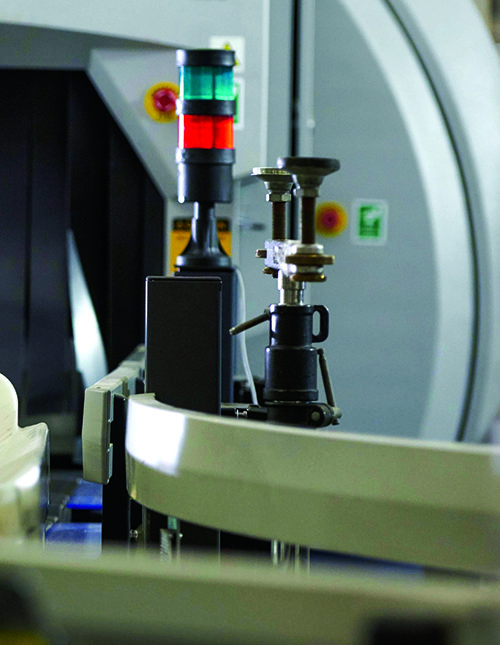
Greener Operation
Airport officials are looking forward to the energy savings the new baggage handling system is designed to deliver. While conventional systems have motors that run continuously, SFO’s new tote-based system employs a start/stop function with electric motors that only turn on when a tote arrives. This ensures a higher level of energy efficiency and low operational costs, explains Delaney.
In addition, its carbon footprint is less than a conventional system’s, which falls in line with SFO’s ongoing commitment to sustainability. The entire Terminal 1 reconstruction project is expected to achieve Gold-level Leadership in Environmental Energy & Design (LEED) certification.
The new CrisBag system aligns with SFO’s overall sustainability goal in several ways, starting with the process load reduction. In general, baggage handling systems are one of the biggest process loads to be accounted for at an airport, Delaney states. With the CrisBag system, there was a considerable reduction of this process load, thereby making the facility more energy efficient.
From a materials perspective, BEUMER is one of the first baggage handling system manufacturers to offer an Environmental Product Declaration and a Health Product Declaration supporting product lifecycle disclosure and material transparency. The considerable low use of materials and energy makes the system a low carbon footprint option.
While tote-based baggage systems are generally more expensive to install than traditional belt-based systems, Delaney notes that reduced energy consumption and longer system life makes them more attractive in terms of total ownership cost.
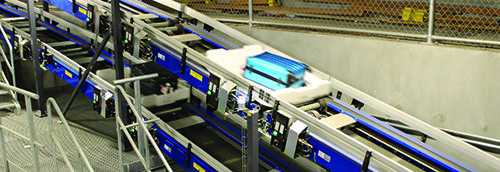
TSA Certification
The CrisBag independent carrier system is the first tote-based baggage handling option to receive TSA approval for both design and operations. BEUMER collaborated closely with the federal agency through workshops and design submittals, and received certification for its totes in March 2017. When used with Morpho’s CTX 9800 DSi explosives detection system, CrisBag totes meet TSA standards for detection and false alarm rates.
Delaney explains that TSA tested the system across a wide range of real-life conditions and situations at its Transportation Systems Integration Facility. Specific elements that were assessed included tracking, throughput, imaging, sorting and detection of missing, unknown and oversized bags. Testers also recorded how quickly the CrisBag system associated specific bags with the individual totes.
Coordinated Construction
Planning, design, construction and commissioning of the new baggage handling system occurred in close concert with SFO’s Terminal 1 Center and Boarding Area B projects. Working on all three together was critical to the success of the baggage system project, notes McCarthy. “If you’re locked in on your structure and then do the bag system later, you have to fit it in; and you don’t get the full benefits,” he explains. “This was like a holistic view of how construction of a baggage handling system could always be if you had a crystal ball.”
During construction of the new system, the airport built an interim baggage handling system to accommodate operations for Southwest Airlines and Frontier Airlines. “The first major phase of the T1 project required us to remove some of the existing bag system,” explains SFO Project Manager Kristin Allen. “We needed to find a solution for those airlines while we tore down the building and before our new bag system was up and running.”
 Adding a separate design-build team for the interim system and another large project that intersected with the larger Terminal 1 reconstruction project could have fatally complicated the overall redevelopment program. But SFO officials were diligent about ensuring all stakeholders were involved early and often in the planning process, says Allen.
Adding a separate design-build team for the interim system and another large project that intersected with the larger Terminal 1 reconstruction project could have fatally complicated the overall redevelopment program. But SFO officials were diligent about ensuring all stakeholders were involved early and often in the planning process, says Allen.
Coordinating with the building designers and contractors made installing the new baggage handling system “that much easier,” adds Delaney. Officially, BEUMER was a subcontractor to the design-builder for Terminal 1 Center, Hensel Phelps/Gensler/Kuth Ranieri. But Boarding Area B’s design-build contract was with Austin Commercial & Webcor Builders joint venture HKS/WoodsBagot/ED2 International/KYA. This arrangement posed a unique situation because the baggage handling system crosses both projects. “How many sites does that work out, where we can build this massive baggage handling system in a building by another contractor where we don’t have a contract?” Delaney marvels. “It’s a testament to SFO’s partnering approach and culture.”
Additionally, all core subcontractors—mechanical, electrical, plumbing, fire protection, special systems, etc.—were involved in the early design and constructability planning meetings.
Building information modeling also figured prominently in the plan. “It really made a difference to make the baggage handling system part of the building, rather than an add-on piece,” Allen says. “Everything was coordinated, and a lot was actually driven by the baggage system to make sure it all worked. If we had brought them in later, we might be redesigning elements of the building.
“Being able to coordinate all of that design utilizing the technology we have really made it work,” she adds.
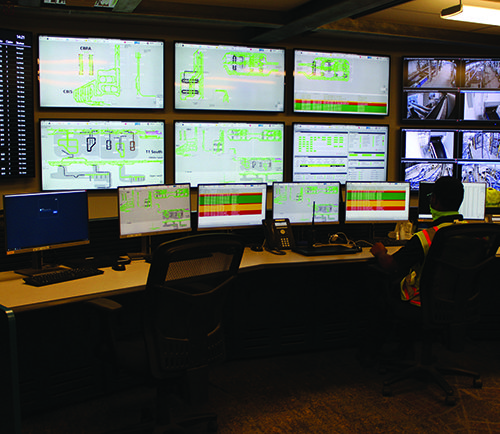
Because construction of the new baggage handling system and terminal occurred concurrently, the project team was able to begin the nearly yearlong commissioning process for the baggage system before the building was complete. “We had a sequence in place where right when commissioning was done, we were finishing up building elements and then we got beneficial use of the baggage handling system,” McCarthy says. He credits all project partners for their flexibility to “retool” how they traditionally do things to facilitate early access so the baggage system could be installed and commissioned sooner than usual.
Delaney says that installing a baggage handling system in a fully constructed terminal can be tricky, but it’s not impossible. “There are always compromises on the system performance and buildability.”
He definitely prefers installing new systems in tandem with terminal construction/renovations. Being looped into SFO’s plans so early was a unique and welcome experience, says Delaney. “In the typical model in the U.S., we’re brought in quite late in the project,” he relates. “In this case, we worked along with the design-build team the whole time.”
SFO is also glad it structured the installation that way. “The sooner you have the bag system contractor on board, the better off everything is going to be,” advises McCarthy.
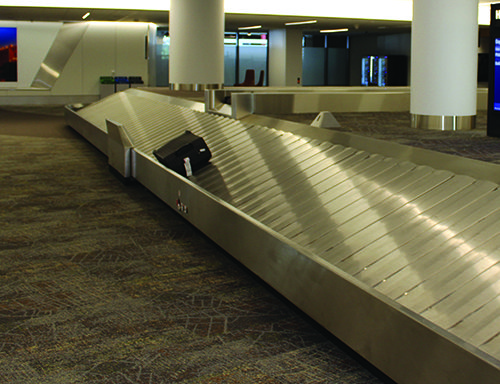

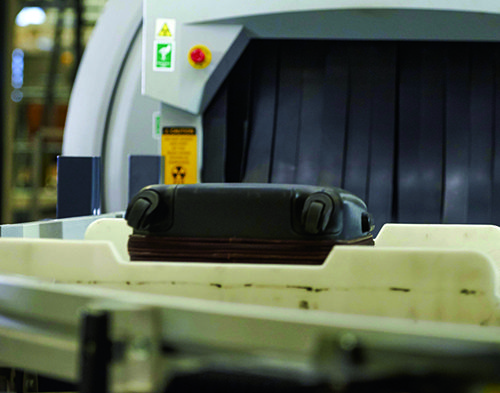
 facts&figures
facts&figures
